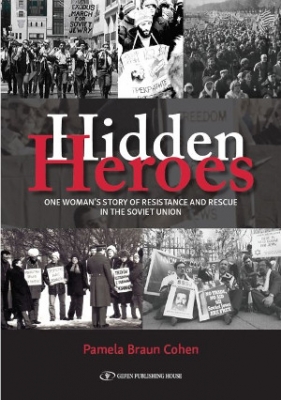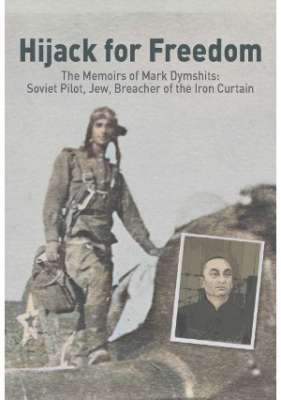2 Book Reviews
| Hijack for Freedom The Memoirs of Mark Dymshits Soviet Pilot, Jew, Breacher of the Iron Curtain Gefen Publishing, 2021 Paperback, 284 pages $24.95 from Gefen or Amazon |
Hidden Heroes One Woman's Story of Resistance and Rescue in the Soviet Union by Pamela Braun Cohen Gefen Publishing, 2021 Hardcover, 424 pages $28 from Gefen, $29.95 on Amazon |
Reviewed by Shlomo Liberman
Two books have recently been published about different aspects of the Soviet Jewry struggle for freedom. The first one is the memoirs of former Soviet air force pilot Major Mark Dymshits who headed an attempt in 1970 to hijack a small airplane and fly to Sweden. The second is Hidden Heroes by Pamela Braum Cohen. She was a housewife in Chicago and became a grassroot organizer of the public struggle for Soviet Jewry, first in the Chicago Action for Soviet Jewry (CASJ) and eventually as the head of the umbrella organization Union of Councils for Soviet Jews (UCSJ).
June 15, 2020, marked the fiftieth anniversary of the failed attempt of a group of fourteen Soviet Jews and two Russian freedom fighters to hijack a small plane which was flying regularly from a small airport near Leningrad to Priozersk near the Finnish border in order to escape the Soviet Union. At the head of this attempt was Mark Dymshits. Sixteen people were involved in the attempt: three Jewish families, including two daughters and one pregnant young woman; four Jewish refuseniks; and two Russian regime opponents. They were not part of any organization and indeed barely knew each other, but they had the same goal: to break through the prison wall of the Soviet regime and go to Israel or any other free country. The international scandal following their trial and brutal sentencing paved the way for hundreds of thousands of Jews to leave the Soviet Union.
Mark Dymshits and a co-defendant were originally sentenced to death but were "saved" by the dictator Franco in Spain who at the same time commuted death sentences for Basque terrorists. The Soviet Union could not be seen as being less lenient than the Spanish dictator. Later, the calls for freedom would crescendo, eventually bringing down the Berlin Wall. In his memoirs, Mark Dymshits recalls his life as a Soviet Jewish citizen and air force pilot and relates the events that led him to concoct the audacious plan.
As the author is not a writer skilled in the art of Creative Writing, the memoirs are written in strict calendar-based format. It therefore takes over 60 pages describing the author's path to becoming a pilot before getting to the heart of the book, the planned (but unexecuted) hijack plan and life in the Soviet Gulag. This latter part is reminiscent of the famous writer Alexander Solzhenitsyn. A remarkable insight into the psyche of many Soviet citizens is the fact that Mark Dymshits long suspected his own wife, Alevtina (Alya) of being a KGB informer.
Hidden Heroes gives a view from the other side, outside the Soviet Union. Spanning nearly three decades, the book gives an insider's view of the modern-day exodus of Soviet Jews from the Soviet Union, a period of Jewish history that has rarely been told and is in danger of being forgotten. This deeply personal narrative explores the grassroots Soviet Jewish emigration movement through the eyes of one of its indefatigable leaders, focusing on the actions of heroic refuseniks in the Soviet Union as well as courageous individuals in the West – described by Natan Sharansky as the "army of students and housewives" who waged the battle to free Soviet Jews.
From Russia, Ukraine, and Lithuania to the distant republics of Central Asia, refuseniks come to life, discovering their identity, protesting on the streets, defending themselves in courtrooms, defying jailers in their prison cells, and struggling to survive in Siberian labor camps. This engrossing memoir tells the story of the resistance and moral courage of men and women inside the Soviet Union and of those in the West who relentlessly crusaded on their behalf.
In a very lucid style, it details the personal story of each refusenik and the role played by the activists in the West. But it also explains how the struggle made use of the American political system to influence US foreign policy and make the struggle for freedom and human rights a pivotal point in negotiations between the US and the Soviet Union on trade concessions. They fully exploited the leverage created by the Jackson-Vanik Amendment to the Trade Act of 1974 which legislated the linkage between Jewish emigration and trade relations.
Pamela Cohen or "Pomella" as the refuseniks used to call her, doesn't shy away from describing the resistance to the public struggle the grassroot activists had to face against both the American Jewish Establishment and even the Israeli government, led by the secretive Lishkat Hakesher. The Lishka organization handled all clandestine contacts with Soviet Jews after the breakoff of diplomatic contacts following the 1967 Six-Day War. The head of the Lishka, Nechemia Levanon, was formally under the Ministry of Foreign Affairs, but reported directly to the Prime Minister's office.
I personally played a minor role In that same struggle by organizing a similar grassroot movement with a small activist group in Västerås, a mid-size town west of Stockholm. We wrote registered letters to refuseniks, taking the cue from another activist student in Aachen, Germany, who had sent 100,000 registered letters most of which were never delivered. He found out that there existed a postal convention which offered automatic compensation to the equivalent of $10-15 (varying according to the price of gold) for each undelivered letter after 3 months. When the German Postal Office refused to pay his group the compensation, he sued them and won an award of over 1 million D-mark which the Bundespost then were forced to reclaim in annual settlement discussions at the Postal Conventions in Geneva. We copied it on a smaller scale by sending hundreds of letters which then financed our activities. We were in contact by mail with two physicists in Tbilisi, Georgia, the Goldsten brothers Isai and Grigory. Grigory Goldstein's ordeals after being sent to a prison camp near the Artic circle, on prison trains are quoted in detail in the book.
" I spent more than two-and-a-half months in prison trains and transit prisons on my way to the labor camp in the Archangelsk region near the Artic Circle. I traveled in a prison train where a sleeping compartment normally containing four persons was packed with seventeen to twenty persons. The only meal between stops in transit prisons, usually located at two- to three-days distance from another, was herring and bread. Water was obtained only at the discretion of the guard, as was permission to use the toilet. The guard often refused one or both, which constituted a form of torture. "
Isai and Grigory Goldstein eventually received exit visas in 1986 after having waited 15 years as refuseniks.
Pamela Braun Cohen's book is a remarkable well-written testimony to the grassroot struggle for Soviet Jewry. Both books are recommended for anyone interested in getting a full picture of the last 60 years of Soviet Jewry history.









Comments